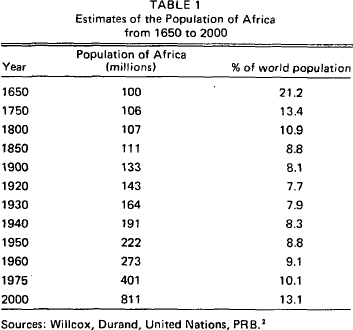No CrossRef data available.
Article contents
African Population Growth and Politics
Published online by Cambridge University Press: 13 August 2021
Extract
The population of Africa in 1977 is estimated to be 423 million, which is about 10.3 percent of the world population. For a quarter of the world’s land area, that is a small population.

Sources: Willcox, Durand, United Nations, PRB.
Africa’s share of world population declined between 1650 and 1920, partly because the population of Europe and the Americas was increasing gradually through factors associated with the Industrial Revolution, and partly because of the ravages of the slave trade and the European colonial pacification measures. Since the 1920s, however, Africa’s population has been growing fast, and its share of world population could reach 13 percent by the year 2000.
- Type
- Research Article
- Information
- Copyright
- Copyright © African Studies Association 1978
References
Notes
1. Population Data for 1977 were taken from Population Reference Bureau (PRB), World Population Datasheet, 1977.
2. Willcox, W. F., Studies in American Demography (Ithaca, N.Y.: Cornell University Press, 1940)Google Scholar; Durand, J. D., “The Modem Expansion of World Population,” Proceedings, American Philosophical Society, 111 (1964), 136–159 Google Scholar; UN, World Population Prospects (New York, 1966); PRB, 1975, 1977 Google Scholar.
3. Clarke, John I., Population Geography and the Developing Countries (New York: Pergamon Press, 1971 ), p. 103 Google Scholar.
4. Ibid.
5. Hance, William A., Population, Migration, and Urbanization in Africa(New York: Columbia University Press, 1970), pp. 5–15 CrossRefGoogle Scholar; Clarke, Population Geography, p. 94.
6. World Bank Atlas, Population, Per Capita Product, and Growth Rate, I BRD, 1972.
7. Som, R. K., “Population Prospects in Africa,” in Ominde, Simeon H. and Ejiogu, C. N., eds., Population Growth and Economic Development in Africa. (London: Heineman, 1972), p. 103 Google Scholar.
8. PRB, World Population Growth and Response 1965-1975, A Decade of Global Action (Washington, D.C., 1976), pp. 35 and 39Google Scholar.
9. Clarke, Population Geography, p. 129.
10. Michael F. Lofchie, “Political and Economic Origins of African Hunger,” The Journal of Modern African Studies, 13 (December 1975).
11. Berry, Len, “Dynamics and Processes of Rural Change,” in Knight, C. G. and Newman, J. L., eds., Contemporary Africa: Geography and Change (Englewood Cliffs: Prentice-Hall, 1976), pp. 221–222 Google Scholar.
12. United Nations Department of Economic and Social Affairs, The Future Growth of World Population, Population Studies No. 28 (New York, 1958), p. 23.
13. Notestein, Frank W., “Population Growth and Its Control,” in Hardin, C. M., ed., Overcoming World Hunger (Englewood Cliffs: Prentice-Hall, 1969), p. 16 Google Scholar.
14. United Nations, Demographic Yearbook, 1966, 1969, 1975.
15. United Nations Department of Economic and Social Affairs, 1965 Report on the World Social Situation (New York, 1966), p. 3.
16. Bouvier, Leon F. and van der Tak, J., “Infant Mortality: Progress and Problems,” Population Bulletin, 31 (April 1976), p. 10 Google Scholar.
17. Ghansah, D. K., “Family Planning and Economic Development in Africa,” in Ominde, and Ejiogu, , Population Growth and Economic Development, p. 112 Google Scholar.
18. Lester R., Brown, World Population Trends: Signs of Hope, Signs of Stress. World Watch Papers 8, 1976 Google Scholar.
19. PRB, World Population Data Sheet, 1977.
20. Lester R., Brown, In the Human Interest (New York: W. W. Norton and Company, 1974), p. 108 Google Scholar; Brand, R. B., “The Urban Housing Challenge,” in Knight and Newman, Contemporary Africa, p. 322 Google Scholar.
21. United Nations Population Division, Trends and Prospects in the Populations of Urban Agglomerations, 1950-2000, as Assessed in 1973-1975, New York, 1975.
22. World Bank Atlas, 1972.
23. Ominde, and Ejiogu, , eds., Population Growth and Economic Development, p. 112 Google Scholar.
24. This section was excerpted from the following sources: PRB, World Population Growth and Response, pp. 27-64; Agency for International Development, “Population Program Assistance: Aid to Developing Countries;” Annual Report, Office of Population, Fiscal Year 1973, Washington, D.C.; Nortman, D., “Population and Family Planning Program, A Fact Book,” Reports on Population/ Family Planning, December 1974, Population Council, New York Google Scholar; and L. F. Bouvier, “Africa and Its Population Growth,” Population Bulletin, 30 (1976).




